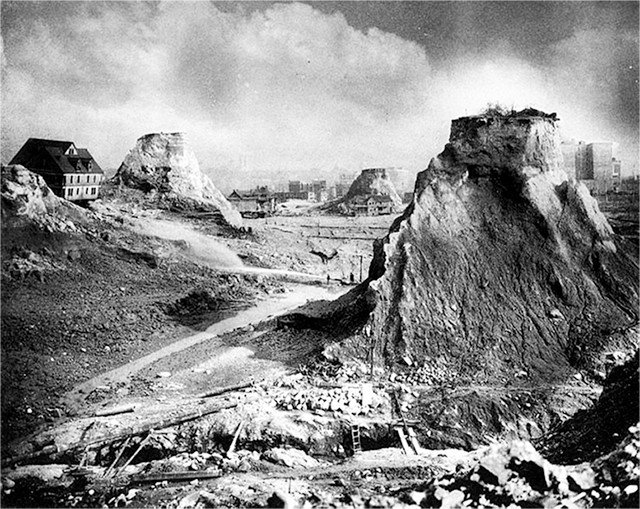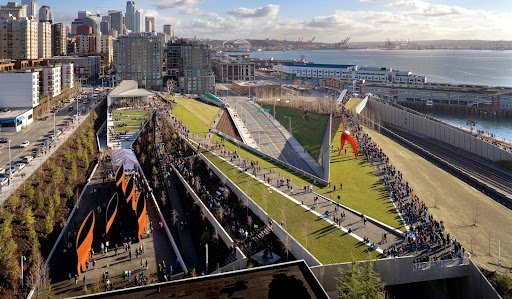Restoring Reciprocity with the Built Environment
By Kort Maeda
Photo Credit: Seattle Municipal Archives, City of Seattle
We at FieldNotes acknowledge that we are on the traditional unceded ancestral lands of the Coast Salish peoples of this land, which touches the shared waters of all tribes and bands within the Duwamish, Puyallup, Suquamish, Tulalip, and Muckleshoot Nations past and present. We honor with gratitude the land itself and the Indigenous Peoples who continue to bring light to their heritage.
Nestled between the Salish Sea and Lake Washington, is a city surrounded by water, mountains, and evergreen forests. Nicknamed “The Emerald City” for its year-round greenery, Seattle became known for its abundance of natural resources that provided local biomes with an abundance of fresh water, reserves of timber, and the benefits of biodiversity.
Seattle’s early city planners sought to capitalize on the resources available and envisioned the creation of an urban hub for the fast-growing economy. The end of the 1800’s marked the beginning of efforts to streamline commerce and the emergence of the notion that humans could improve upon nature to function more effectively for our use. The city council gradually gained constituent support to regrade hills, lower lakes, and dig canals. Perhaps the most drastic changes were the straightening of the Duwamish River, from a meandering source of water to a channel drained of life, and the flattening of Denny Hill with hydraulic water cannons. In reconstructing aspects of the natural landscape, the foundation of Seattle’s built environment, the streets, buildings, bridges, and urban infrastructure, reflects a western worldview where there is a distinct separation between humans and nature.
The infamous “spite mounds” left around the city during the 1900s were supposedly by land owners who didn’t agree with the regrade, from University of Washington Special Collections.
Despite this extensive manipulation, Seattle is viewed as the gem of the Pacific Northwest from both outsider and conservationist perspectives. But historically exclusive conservationist views erase the ongoing history of the first people of Seattle, the Duwamish, who share narratives of positive interactions between humans and the environment. Unlike the western ideal of dividing landscape into settled regions and "wilderness", an Indigenous worldview recognizes the importance of managing and working alongside all of nature rather than ravaging it in some locations and barring humans entirely from others. In placing an emphasis on conserving land by leaving it “untouched”, western-centric natural history does not acknowledge the generations of positive reciprocal relationships that Indigenous people have with the land.
Looking at Seattle as a case study illustrates the need to address environmental injustice within the context of urban green spaces. The reality is a highly modified landscape, arguably the most reengineered city in the United States. Across Seattle’s neighborhoods, city plans and discriminatory policies favor predominantly white areas with high median incomes, contributing to a growing disparity in access to urban green spaces. The aftermath of the historic practices of redlining can be seen in comparing the population demographics of North and South Seattle to the accessibility of urban green space access. Home to many of the first immigrant communities, BIPOC neighborhoods in South Seattle have some of the lowest tree canopy densities and are burdened with some of the highest numbers of heat-related illnesses.
In the past, our affinity for nature, coined as the term “biophilia” by Erich Fromm, has been cross-cultural and necessary for survival. People who paid attention to nature were more likely to pass on their wisdom to future generations. Knowledge about the world around us remains directly linked to our future as the way we perceive the environment motivates the decisions we make on a daily basis. But, as human activities continue to be detrimental, our baseline understanding of what our natural environment should look like has shifted. As the environment changes around us, we are unable to recognize substantial changes that are happening, leaving us unaligned with the reality of the impacts of climate change.
What does a mutual understanding of the environment look like? The act of reciprocity is a chance for us to reassess how we interact with our surrounding environment. It is a chance for us to recenter our thinking away from being separate from nature to being part of nature. Time spent in nature makes us better people, bringing us outside the four walls of our individual lives while creating spaces for meaningful connection with each other and the environment. In cities, reciprocity with the built environment can look like inclusive urban green spaces that are intentionally designed for and by historically marginalized neighborhoods. Reciprocity can take the form of any green infrastructure that shifts away from conventional concrete solutions and toward nature-based solutions because at its core, reciprocity with the environment is acknowledging and appreciating the ways the earth cares for us.
The Olympic Sculpture Park in Downtown Seattle, built on the abandoned fuel storage site on the waterfront, features native plants and accessible pathways, as a 2011 effort to increase urban green space in historically marginalized communities, from The New York Times.



